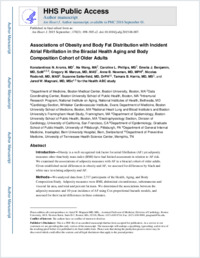Associations of obesity and body fat distribution with incident atrial fibrillation in the biracial health aging and body composition cohort of older adults.
- Aronis KN Department of Medicine, Boston Medical Center, Boston University, Boston, MA.
- Wang N Data Coordinating Center, Boston University School of Public Health, Boston, MA.
- Phillips CL Intramural Research Program, National Institute on Aging, National Institutes of Health, Bethesda, MD.
- Benjamin EJ Cardiology Section, Whitaker Cardiovascular Institute, Evans Department of Medicine, Boston University School of Medicine, Boston, MA; National Heart Lung and Blood Institute's and Boston University's Framingham Heart Study, Framingham, MA; Department of Epidemiology, Boston University School of Public Health, Boston, MA.
- Marcus GM Electrophysiology Section, Division of Cardiology, University of California, San Francisco, CA.
- Newman AB Department of Epidemiology, Graduate School of Public Health, University of Pittsburgh, Pittsburgh, PA.
- Rodondi N Department of General Internal Medicine, Inselspital, Bern University Hospital, Bern, Switzerland.
- Satterfield S Department of Preventive Medicine, University of Tennessee Health Science Center, Memphis, TN.
- Harris TB Intramural Research Program, National Institute on Aging, National Institutes of Health, Bethesda, MD.
- Magnani JW Cardiology Section, Whitaker Cardiovascular Institute, Evans Department of Medicine, Boston University School of Medicine, Boston, MA; National Heart Lung and Blood Institute's and Boston University's Framingham Heart Study, Framingham, MA. Electronic address: jmagnani@bu.edu.
- 2015-09-20
Published in:
- American heart journal. - 2015
Aged
Aging
Atrial Fibrillation
Body Composition
Body Fat Distribution
Continental Population Groups
Female
Follow-Up Studies
Humans
Incidence
Male
Obesity
Prospective Studies
Risk Factors
Sex Factors
Time Factors
United States
English
UNLABELLED
Obesity is a well-recognized risk factor for atrial fibrillation (AF), yet adiposity measures other than body mass index (BMI) have had limited assessment in relation to AF risk. We examined the associations of adiposity measures with AF in a biracial cohort of older adults. Given established racial differences in obesity and AF, we assessed for differences by black and white race in relating adiposity and AF.
METHODS
We analyzed data from 2,717 participants of the Health, Aging, and Body Composition Study. Adiposity measures were BMI, abdominal circumference, subcutaneous and visceral fat area, and total and percent fat mass. We determined the associations between the adiposity measures and 10-year incidence of AF using Cox proportional hazards models and assessed for their racial differences in these estimates.
RESULTS
In multivariable-adjusted models, 1-SD increases in BMI, abdominal circumference, and total fat mass were associated with a 13% to 16% increased AF risk (hazard ratio [HR] 1.14, 95% CI 1.02-1.28; HR 1.16, 95% CI 1.04-1.28; and HR 1.13, 95% CI 1.002-1.27). Subcutaneous and visceral fat areas were not significantly associated with incident AF. We did not identify racial differences in the associations between the adiposity measures and AF.
CONCLUSION
Body mass index, abdominal circumference, and total fat mass are associated with risk of AF for 10years among white and black older adults. Obesity is one of a limited number of modifiable risk factors for AF; future studies are essential to evaluate how obesity reduction can modify the incidence of AF.
Obesity is a well-recognized risk factor for atrial fibrillation (AF), yet adiposity measures other than body mass index (BMI) have had limited assessment in relation to AF risk. We examined the associations of adiposity measures with AF in a biracial cohort of older adults. Given established racial differences in obesity and AF, we assessed for differences by black and white race in relating adiposity and AF.
METHODS
We analyzed data from 2,717 participants of the Health, Aging, and Body Composition Study. Adiposity measures were BMI, abdominal circumference, subcutaneous and visceral fat area, and total and percent fat mass. We determined the associations between the adiposity measures and 10-year incidence of AF using Cox proportional hazards models and assessed for their racial differences in these estimates.
RESULTS
In multivariable-adjusted models, 1-SD increases in BMI, abdominal circumference, and total fat mass were associated with a 13% to 16% increased AF risk (hazard ratio [HR] 1.14, 95% CI 1.02-1.28; HR 1.16, 95% CI 1.04-1.28; and HR 1.13, 95% CI 1.002-1.27). Subcutaneous and visceral fat areas were not significantly associated with incident AF. We did not identify racial differences in the associations between the adiposity measures and AF.
CONCLUSION
Body mass index, abdominal circumference, and total fat mass are associated with risk of AF for 10years among white and black older adults. Obesity is one of a limited number of modifiable risk factors for AF; future studies are essential to evaluate how obesity reduction can modify the incidence of AF.
- Language
-
- English
- Open access status
- green
- Identifiers
-
- DOI 10.1016/j.ahj.2015.06.007
- PMID 26385033
- Persistent URL
- https://sonar.ch/global/documents/157826
Statistics
Document views: 14
File downloads:
- fulltext.pdf: 0
